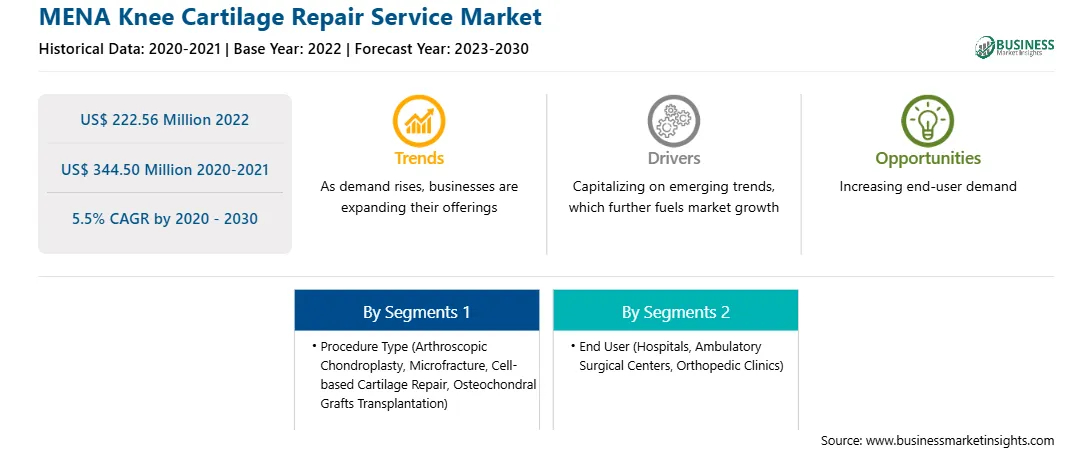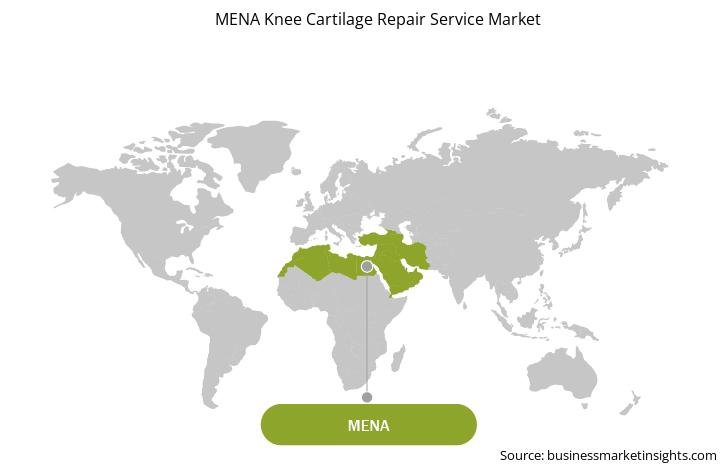The knee cartilage repair service market size was valued at US$ 222.56 million in 2022 and is expected to reach US$ 344.50 million by 2030. It is estimated to register a CAGR of 5.5% during 2020–2030.
Knee cartilage repair is a type of treatment for knee preservation. The knee cartilage damage usually occurs in younger people (less than 50 years) as a result of twisted knee, smashed kneecap, or fractured knee. Cartilage may wear down over time as part of natural aging for the people over 50. Knee cartilage repair depends on factors including the depth, size, and location of the torn knee cartilage, associated knee injuries, patient’s activity level, and patient’s weight and age. Although a few cartilage injuries can be treated non-operatively, a surgical knee cartilage treatment is commonly recommended in cases with a focal cartilage defect. The most common knee cartilage repair procedures are microfracture and chondroplasty.
3D printing technologies are gaining a lot of attention in the medical sector. Technological advancements have allowed 3D bioprinting (3DBP) for cartilage as the 3D printing technology allows precise control of internal architecture and geometry of printed scaffolds and has shown promising strategies in cartilage restoration. However, more research is required to accept 3D printing for cartilage. 3D printing requires bioinks with proper chemical and mechanical properties that play vital roles in designing successful cartilage tissue constructs. Extrusion-based, digital-light processing, and drop-on-demand inkjet techniques are used in cartilage repair that uses novel bioinks. The above-mentioned techniques have been associated with several advantages and disadvantages. The advantages and disadvantages are given in the table below.
Advantages and Disadvantages of 3D Printing Techniques
|
|
|
|
| Support cell-laden bioinks | Superior vertical structure fidelity | Medium printing speed |
Moderate-resolution | High resolution | High cell viability (>85%) | |
Improved shape fidelity | Mild condition for cells (viability: 85–95%) |
| |
| Slow printing speed | Separating force between the platform and the printed surface | Poor structure fidelity |
Inferior cell viability (40–80%) | May need the addition of a cytotoxic photo initiator | Low cell density (<106 cells mL − 1) | |
Expensive |
|
|
Source: Advanced 3D-Printing Bioinks for Articular Cartilage Repair, published by the National Library of Medicine in April 2022
At present, 3D bioprinting is highly used in articular cartilage repair, which generally cannot self-regenerate as it lacks vessels and nerves. Thus, considering the advantages of the 3D-printing and the constant improvement in the technologies for cartilage repair using novel bioinks, 3D bioprinting is likely to become a promising therapy for clinical use soon, and can leverage the market's growth.
By End User, Knee Cartilage Repair Service Market -Based Insights
Based on end user, the knee cartilage repair service market is divided into hospitals, ambulatory surgical centers, and orthopedic clinics. The hospitals segment held the largest share of the market in 2022. The same segment is anticipated to register the highest CAGR in the market during 2022–2030. The hospitals segment is the largest end user segment in the knee cartilage repair service market. The segment's growth is attributed to the increased number of procedures for knee injuries and other orthopedic treatments. Hospitals provide treatment with specialized nursing staff and medical equipment.
SportsMD.com, National Center for Biotechnology Information are a few of the major secondary sources referred to while preparing the report on the knee cartilage repair service market.
Strategic insights for the MENA Knee Cartilage Repair Service provides data-driven analysis of the industry landscape, including current trends, key players, and regional nuances. These insights offer actionable recommendations, enabling readers to differentiate themselves from competitors by identifying untapped segments or developing unique value propositions. Leveraging data analytics, these insights help industry players anticipate the market shifts, whether investors, manufacturers, or other stakeholders. A future-oriented perspective is essential, helping stakeholders anticipate market shifts and position themselves for long-term success in this dynamic region. Ultimately, effective strategic insights empower readers to make informed decisions that drive profitability and achieve their business objectives within the market.

| Report Attribute | Details |
|---|---|
| Market size in 2022 | US$ 222.56 Million |
| Market Size by 2030 | US$ 344.50 Million |
| Global CAGR (2020 - 2030) | 5.5% |
| Historical Data | 2020-2021 |
| Forecast period | 2023-2030 |
| Segments Covered |
By Procedure Type
|
| Regions and Countries Covered | MENA
|
| Market leaders and key company profiles |
The geographic scope of the MENA Knee Cartilage Repair Service refers to the specific areas in which a business operates and competes. Understanding local distinctions, such as diverse consumer preferences (e.g., demand for specific plug types or battery backup durations), varying economic conditions, and regulatory environments, is crucial for tailoring strategies to specific markets. Businesses can expand their reach by identifying underserved areas or adapting their offerings to meet local demands. A clear market focus allows for more effective resource allocation, targeted marketing campaigns, and better positioning against local competitors, ultimately driving growth in those targeted areas.

The MENA Knee Cartilage Repair Service Market is valued at US$ 222.56 Million in 2022, it is projected to reach US$ 344.50 Million by 2030.
As per our report MENA Knee Cartilage Repair Service Market, the market size is valued at US$ 222.56 Million in 2022, projecting it to reach US$ 344.50 Million by 2030. This translates to a CAGR of approximately 5.5% during the forecast period.
The MENA Knee Cartilage Repair Service Market report typically cover these key segments-
The historic period, base year, and forecast period can vary slightly depending on the specific market research report. However, for the MENA Knee Cartilage Repair Service Market report:
The MENA Knee Cartilage Repair Service Market is populated by several key players, each contributing to its growth and innovation. Some of the major players include:
The MENA Knee Cartilage Repair Service Market report is valuable for diverse stakeholders, including:
Essentially, anyone involved in or considering involvement in the MENA Knee Cartilage Repair Service Market value chain can benefit from the information contained in a comprehensive market report.